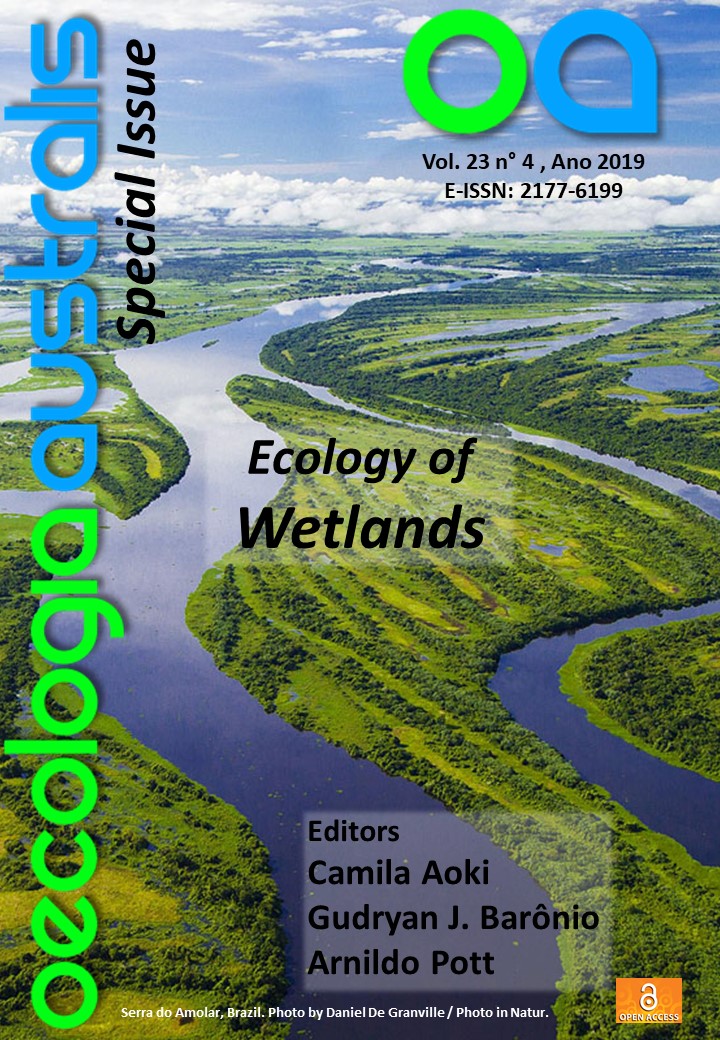Thalia geniculata L. (MARANTACEAE): A PLANT THAT PRODUCES A PSEUDANTHIUM WITH TWO FLOWERS, TWO OVARIES BUT JUST ONE FRUIT
DOI:
https://doi.org/10.4257/oeco.2019.2304.28Palavras-chave:
floral display, inflorescence mechanisms, Pantanal, pollinator behavior, reproductionResumo
Thalia geniculata L. (Zingiberales, Marantaceae) has inflorescences with two simultaneously opening, hermaphroditic, single-day flowers, which form a pseudanthium. The species has an irreversibly explosive pollination mechanism. In one population of T. geniculata we verified that in 98.5% of the pseudanthia, only one flower from each pair set fruit. We assessed whether this fruit-set pattern could be linked to pollinator behavior, testing if pollinators only visit one flower in each pseudanthium, which would decrease visitation probability of the other flower in the pseudanthium. In the morning, less flowers were visited than in the afternoon, and we observed higher pollinator activity in the afternoon. In the morning, most of the visited pseudanthia had only one flower visited, while in the afternoon most pseudanthia had both flowers visited, the opposite of what we predicted. We concluded that single fruit set in the pseudanthia is not caused by pollinator behavior. It might be caused by pollen limitation during pollinator visits or even resource limitation to support two fruits per pseudanthia.
Referências
Andersson, L. 1981. Revision of the Thalia geniculata complex (Marantaceae). Nordic Journal of Botany, 1(1), 48-56. DOI: 10.1111/j.1756-1051.1981.tb01034.x
Arizaga, S., & Ezcurra, E. 1995. Insurance against reproductive failure in a semelparous plant: Bulbil formation in Agave macroantha flowering stalks. Oecologia, 101(3), 329-334. DOI: 10.1007/BF00328819
Austerlitz, F., Gleiser, G., Teixeira, S., & Bernasconi, G. 2012. The effects of inbreeding, genetic dissimilarity and phenotype on male reproductive success in a dioecious plant. Proceedings of the Royal Society B: Biological sciences, 279(1726), 91-100. DOI: 10.1098/rspb.2011.0652
Benitez-Vieyra, S., Moré, M., & Amorim, F. 2014. Seleção fenotípica mediada por polinizadores. In: A. R. Rech, K. Agostini, P. E. A. M. Oliveira, & I. C. Machado (Eds.), Biologia da Polinização. Rio de Janeiro: Editora Projeto Cultural: p. 524.
Best, L., & Bierzychudek, P. 1982. Pollinator foraging on foxglove (Digitalis purpurea): A test of a new model. Evolution, 36(1), 70-79. DOI: 10.2307/2407968
Brito, V. L. G., Telles, F., & Lunau, K. 2014. Ecologia cognitiva da polinização. In: A. R. Rech, K. Agostini, P. E. A. M. Oliveira, & I. C. Machado (Eds.), Biologia da Polinização. Rio de Janeiro: Editora Projeto Cultural: p. 524.
Cadavid-Garcia, E.A. 1984. O clima no Pantanal Mato- Grossense. Corumbá: EMBRAPA/UEPAE: p. 42.
Caruso, C. M., Eisen, K. E., Martin, R. A., & Sletvold, N. 2018. A meta-analysis of agents of selection on floral traits. Evolution 73(1), 4-14. DOI: 10.1111/evo.13639
Classßen-Bockhoff, R. 1990. Pattern analysis in pseudanthia. Plant Systematics and Evolution 171, 57-88. DOI: 10.1007/BF00940596
Claßen-Bockhoff, R. 1991. Investigations on the construction of the pollination apparatus o Thalia geniculata (Marantaceae). Botanica Acta, 104(3), 183-193. DOI: 10.1111/j.1438-8677.1991.tb00215.x
Claßen-Bockhoff, R., & Heller, A. 2008. Floral synorganization and secondary pollen presentation in four marantaceae from Costa Rica. International Journal of Plant Sciences, 169(6), 745-760. DOI: 10.1086/588069
Cruden, R.W. 2000. Pollen grains: why so many? Plant Systematics and Evolution, 222, 143-165.
Davis, M. A. 1987. The role of flower visitors in the explosive pollination of Thalia geniculata (Marantaceae), a Costa Rican marsh plant. Bulletin of the Torrey Botanical Club, 114(2), 134-138. DOI: 10.2307/2996122
Giurfa, M., Vorobyev, M., Kevan, P., & Menzel, R. 1996. Detection of coloured stimuli by honeybees: minimum visual angles and receptor specific contrasts. Journl of Comparative Physiology A, 178, 699-709. DOI: 10.1007/BF00227381
Goulson, D., Sout, J. C., Hawson, S. A., & Allen, J. A. 1998. Floral display size in comfrey, Symphytum officinale L. (Boraginaceae): relationships with visitation by three bumblebee species and subsequent seed set. Oecologia, 113(4), 502-508. DOI: 10.1007/s004420050402
Fenster, C. B., Diggle, P. K., Barrett, S. C. H., & Ritland, K. 1995. The genetics of floral development differentiating two species of Mimulus. Heredity, 74, 258-266.
Harder, L. D., & Wilson, W. G. 1994. Floral evolution and male reproductive success: Optimal dispensing schedules for pollen dispersal by animal-pollinated plants. Evolutionary Ecology, 8(5), 542-559. DOI: 10.1007/BF01238257
Hawkeswood, T. J., & Sommung, B. 2016. Observations on nectar robbing of Thalia geniculata L. (Marantaceae) flowers by two species of hawkmoths (Lepidoptera: Sphingidae) in Thailand. Calodema, 417, 1-5.
Jerominek, M., Will, M., & Claßen-Bockhoff, R. 2018. Insights into the inside - A quantitative histological study of the explosively moving style in Marantaceae. Frontiers in Plant Science, 9, 1695. DOI: 10.3389/fpls.2018.01695
Jesson, L. K., & Barrett, S. C. H. 2002. The genetics of mirror-image flowers. Proceedings of the Royal Society of London - Series B: Biological Sciences, 269(1502), 1835-1839. DOI: 10.1098/rspb.2002.2068
Jesson, L. K., & Barrett, S. C. H. 2003. The comparative biology of mirror-image flowers. International Journal of Plant Sciences, 164(5), 237-249.
Leite, A. V., & Machado, I. C. 2007. Fenologia reprodutiva, biologia floral e polinizadores de duas espécies simpátricas de Marantaceae em um fragmento de Floresta Atlântica, nordeste do Brasil. Revista Brasileira de Botânica, 30(2), 221-231. DOI:10.1590/S0100-84042007000200007
Ley, A. C., & Claßen-Bockhoff, R. 2009. Pollination syndromes in African Marantaceae. Annals of Botany, 104(1), 41-56. DOI: 10.1093/aob/mcp106
Kirchoff, B. K. 1986. Inflorescence structure and development in the Zingiberales: Thalia geniculata (Marantaceae) Canadian. Journal of Botany, 64(4), 859-864. DOI: 10.1139/b86-112
Rathcke, B. 1983. Competition and facilitation among plants for pollination. In: L. Real (Ed.), Pollination biology. pp. 305-329. Orlando: Academic Press Inc..
Rodríguez, I., Gumbert, A., Ibarra, N. H., Kunze, J., & Giurfa, M. 2004. Symmetry is in the eye of the 'beeholder' innate preference for bilateral symmetry in flower-naive bumblebees. Naturwissenschaften 91(8), 374-377. DOI: 10.1007/s00114-004-0537-5
Silva, M. P., Mauro, R., Mourão, G., & Coutinho, M. 2000. Distribuição e quantificação de classes de vegetação do Pantanal através de levantamento aéreo. Revista Brasileira de Botânica, 23(2), 143-152.
Stephenson, A. G., & Bertin, R. I. 1983. Male competition, female choice and sexual selection in plants, pp. 110-151. In: L. Real (Ed.), Pollination biology. Orlando: Academic Press Inc.


